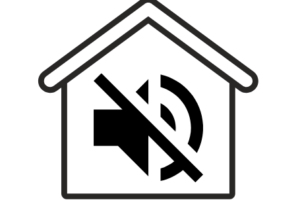There are so many people who don’t soundproof our rooms because of the fear that it’ll leave the room space crunched. Or maybe some other restrictions such rent agreements hold them back. I get it- I live in a rented accomodation myself, but I figured there just HAS to be some way to improve the situation.
I researched this for a bit on the internet and I found 9 easy ways to soundproof a room without losing much space:
- Mass Loaded Vinyl
- Acoustic Drapes/Curtains
- Egg Crates
- Carpeting
- Door Sweep
- Double Sided Insulation Tape For Window
- Install Acoustic Glass
- Reinforce Your Door
- Book Shelves
I tried to cover the whole array of places that sound might be leaking into your room through. Everyone’s situation is different though- so you should look at these tips as something you should do only if it’s applicable to you. Eg: If your windows are really thick and already block most of the noise, them applying insulation tape there would give you diminishing returns.
Let’s take a look at what I mean in more detail:
3 Permanent Solutions That You Should Look Into
#1 Mass Loaded Vinyl(MLV)
This method is probably the most comprehensive one but requires a fair bit of construction work. You’ll need to remove the existing drywall and add a layer of mass loaded vinyl soundproofing material in between before re-applying the drywall.
If you’re not comfortable doing this, you might want to consider getting professional help or skipping over to the next method. Keep in mind that this method is also more expensive than the others on this list.
The way this product works is by adding mass to the wall. It’s really heavy and it generally takes two people to install it. But this is for a good reason- the thick MLV layer helps decrease the vibrations of the sound waves travelling through the wall.
You can easily find MLV sheets on Amazon. I also found out that using Green Glue damping compound to stick the MLV onto your walls is a good idea- and gives the wall an additional acoustic reinforcement.
And if you’re going to go all the way with this, you should also get acoustic putty for spreading around the electricity outlets in the wall- which are also areas where sound tends to leak through.
As for space, doing this entire exercise shouldn’t add on more than 0.5 mm thickness to your walls- not really bad for the MASSIVE soundproofing benefits it provides
#2 Acoustic Glass Window
The most permanent thing you could do is to remove your existing glass window and install reinforced acoustic glass. There are many specialty solutions available, and they are expensive for sure, roughly about 800-1000 $ including installation charges BUT if you really need to soundproof your room drastically, this will do the trick.
You won’t need to look at acoustic curtains and whatnot if you’ve invested in acoustic glass.
#3 Reinforce Your Doors
There are plenty of serious solutions for soundproofing a door properly. Generally, if your door is hollow from the inside or is made up of metal, you’ll need to to take a look at the link above.
If you have solid wood doors, even then, sound might be leaking from around the sides if there are any air gaps- so consider getting some soundproofing rubber and acoustic caulk.
Some Quick Wins For Soundproofing The Room Without Losing Space
These aren’t 100% effective, but if you’re on a limited budget AND need to save space, they’ll be effective enough.
#4 Acoustic Drapes/Curtains
These are helpful for deadening the sound entering the room through the windows- but of course aren’t as effective as, say a proper acoustic glass treatment which is a more permanent solution.
They will help improve the situation though, and are a good quick fix. Another thing you could do is buy 2 sets and apply them back to back on your window. This should really make a bigger difference.
The main benefit is that these curtains help reduce the echo inside the room, i.e improve acoustics. This makes the room feel quieter and more peaceful than before.
If you’re interested, you should check out these acoustic curtains on Amazon– they’re the most popular ones on the site with close to 90% positive reviews.
#5 Egg Crates
Truly the cheapest solution here. Please don’t expect a lot from this- the thickness of an egg crate is too little to be able to offer any considerable amount of soundproofing.
People generally take a couple of layers, stack them together and stick them on the walls using glue or staples.
While this obviously looks ugly, it also is a fire hazard and I wouldn’t recommend you do this. It will give you a very marginal amount of soundproofing, if at all.
#6 Carpeting
This one is more for keeping the sound inside your room rather than outside. Consider adding a full- floor length carpeting in order to properly muffle your footsteps or any other sounds that might carry through your floor and into the house/floor below yours.
What about getting a couple of rugs instead?
Carpeting in itself, isn’t the most permanent solution- however it does the job just enough that I included it in this post. I would advise against even thinking of getting a few rugs, and being done with it, as some articles suggest. It will NOT help you.
#7 Door Sweep
Another way that sound creeps into a room is under the door- more so if it’s improperly sized. My balcony door is and it makes a racket everytime it’s windy and the wind comes through into my room from under the door.
Getting a simple door sweep, like this one on Amazon is a good idea- it’s quite inexpensive and even a child could install it.
#8 Double Sided Insulation Tape For Windows And Doors
Sometimes the window frames are improperly sized and you may notice some gaps between the frame and the glass. In these cases, it is best to apply some insulation tape to close off the gap.
This applies to doors also, so do inspect both of these carefully for any gaps. If you see any, then you know what to do.
#9 Book Shelves
Only applies if you already have one in your room or if you can afford to give up some space for a bookshelf.
A nice wooden bookshelf, filled with as many books as possible is great little cheap trick for blocking sound transmissions from the wall.
Of course, you need to place the shelf against the wall from which most of the sound pollution emanates. The higher surface area of the wall that it covers, the better it is.
Conclusion
Getting started with soundproofing can be daunting, and you might just need professional help sometimes.
However, it is worth spending some time and learning about things YOU can do to improve your situation and make an informed decision.
This article was all about that while keeping in mind the space constraint that most of us have, living in tightly packed urban areas.
Hope this helped, and if you have any questions- don’t hesitate to jump into the comments section below.


